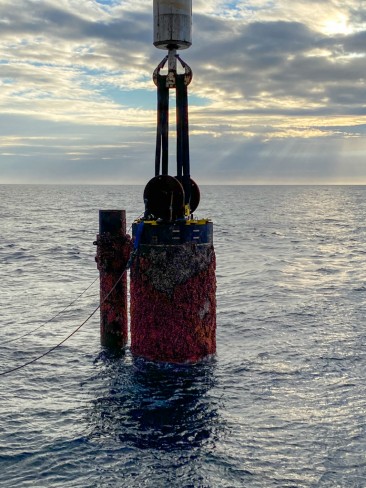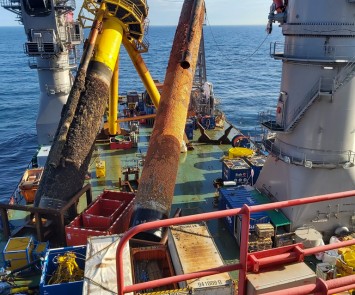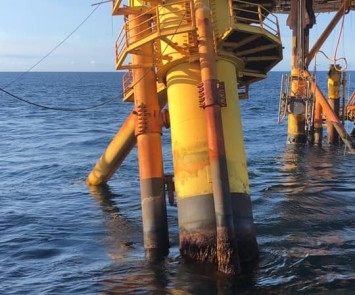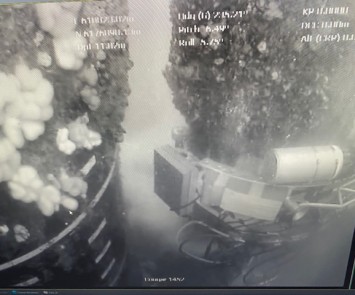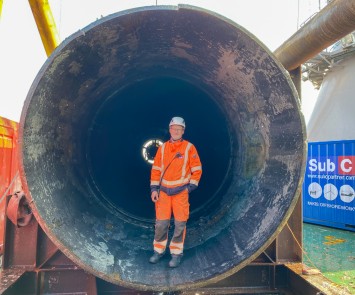An innovative decommissioning operation
Dredging & Cutting
It is a complex and critical job performing dredging and cutting of steel structures 3 meters below the seabed.
It required an innovative approach since our main objective for the operation was to perform the work without having personnel subsea to increase efficiency and safety.
The operation was carried out using a combination of our award-winning Robotic Crawler System and Abrasive Water Cutting. The crawlers were launched by ROV, and we dredged an area to ensure enough space for the cutting sequence below the seabed.
A part of Tyra Redevelopment
Tyra is Denmark’s largest gas field and export centre for all gas produced in Danish Underground Consortium. The redevelopment of Tyra ensures continued production from the field by extending its operational lifetime at least 25 years. This means that Denmark can remain self-sufficient with gas.
The facilities of the Tyra field were suffering from seabed subsidence due to many years’ production. Therefore, the existing facilities are being upgraded with new topsides, which will be installed at higher elevations, in order to continue the exploitation of existing reserves from Tyra and the associated satellites. The Tyra platforms are operated by Total E&P DK.
SubC was initiating the campaign at Tyra mid-July 2020, and the last cut was performed around a month later.
A revolutionised decommissioning method
In phase 4 of the Tyra Redevelopment Project, four jacket structures and an IPF monopile were to be removed. SubC was awarded the project of cutting the leg piles and skirt piles of the jacket structures as well as the IPF monopile and its related caisson.
Allseas’ Pioneering Spirit, the largest construction vessel in the world, had the job of removing the 7,800 tonnes Tyra West A (TWA) topsides at the Tyra field. This could not be done before our specialist and award-winning robotic crawlers had removed the IPF monopile.
Intelligent cutting 3 meters below seabed
The project of cutting the IPF monopiles being 3.000 mm in diameter and its related caisson being 1.016 mm in diameter included 3 critical cuts subsea:
- 1 cut – a 90 degrees cut, 20 mm thick (caisson)
- 1 cut 8 metres below the waterline – a 30 degrees cut, 73 mm thick (monopile)
- 1 cut 3 metres below the seabed – a 90 degrees cut, 60 mm thick (monopile)
The cutting of the leg piles and skirt piles were carried out 3 meters below seabed, equaling 40 meters below sea level. To obtain the required space for the operation, our specialist dredged an area related to each cut, 6 metres below the seabed.
- The cutting operation of the skirt piles included 30 cuts on Tyra East D (TED) and Tyra West D (TWD) combined.
- The cutting operation of the leg piles included 6 true horizontal cuts on Tyra East D (TED) and Tyra West D (TWD) combined.
When the cuts were performed, the flare jackets, TED & TWD, were lifted to Allseas’ construction support vessel Fortitude, which transported the structure for disposal onshore.
The crawlers were launched by ROV and the operations controlled from our 10’ containerized control unit safely placed on Fortitude.
Abrasive Water Cutting using the Robotic Crawler
The cutting sequence was carried out using SubC’s patented and award-winning Robotic Crawler System, as our main objective for solving the project was to perform the work without having personnel subsea. The crawlers were mounted on the leg, skirt piles, the IPF monopile and its related caisson using ROV, as a ROV can relocate the crawlers within the jacket structure to cut at various locations. For cut execution, the crawlers were fitted with Abrasive Water Cutting Nozzles, which were penetrating the tubular using a mixture of sand and water jetting at ultra-high pressures.
Robots being 1 - 3 meters in diameter
For the campaign, 6 new versions of the crawler were developed and built, and the largest can hook on to structure being 3 meters in diameter. Engineering and practice onshore took place simultaneously as our philosophy is to practice onshore so we can do our work offshore.
Software built to control the positioning
Also, for the true horizontal cuts, three positioning towers were developed and built, and the towers were controlled by software. The software made by SubC’s System Developer was being used to control the cut verification and the exact XY positioning of the crawlers.
The advantages of the solution
Normally, Diamond Wire Cutting is the method chosen but, in this situation, it would cause too many challenges. Therefore, we decided to use abrasive water cutting to avoid the risk of a sawing wire being stuck under the weight of the platform while cutting. The implication of this risk is time, and in the offshore industry, time is always an important factor. The advantage of the cutting method is, therefore, a possible cost reduction.
Also, this method is done without using divers as the operations will be controlled from a container. It is a cutting operation consisting of too powerful pressures for us to allow personnel near the cutting. The advantage of the cutting method is, therefore, also improved safety.
Further, a ROV can relocate the crawler within the jacket structure to cut at various locations without having the crawler out of the water. and the crawlers can operate night and day – all time of the year. The advantage of the cutting method is, therefore, also a possible and significant time-saving solution.
Applications for the Robotic Crawler
- Abrasive Water Cutting
- Close Visual Inspection
- Diamond Wire Cutting
- Eddy Current Inspection
- Inspection of Flooded Members
- Marine Growth Removal
- Ultrasonic Thickness Measurement
Awards – the Robotic Crawler System
April 2019: Won Total’s Best Innovators Award in the category of Technical Innovation Solutions for the North Sea and Russia.
July 2019: The Robotic Crawler was among the Global top 10 at the Total E&P Best Innovators Award in Paris.
May 2020: Won Next Step Challenges’ Award in the offshore category for the best idea, team, and potential.
June 2020: Won Scale-Up Denmark’s Award “The most scalable company of the year” 2020.
